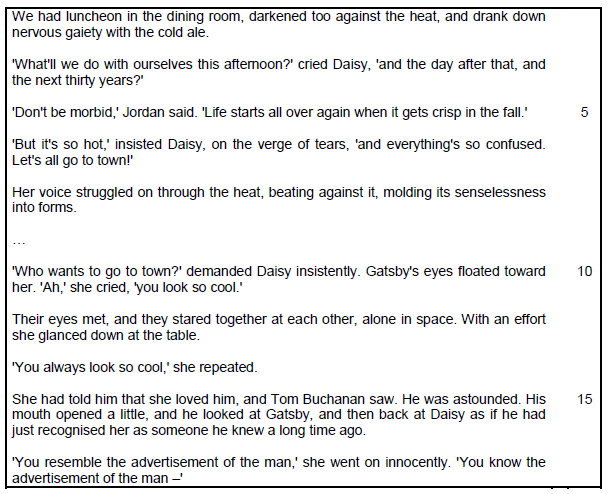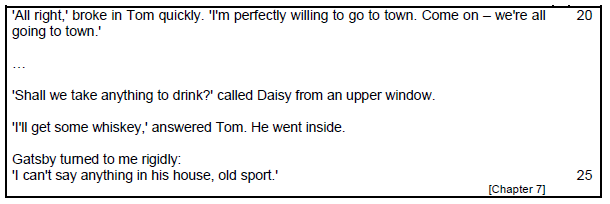ENGLISH HOME LANGUAGE PAPER 2 GRADE 12 QUESTIONS - NSC PAST PAPERS AND MEMOS FEBRUARY/MARCH 2016
Share via Whatsapp Join our WhatsApp Group Join our Telegram GroupENGLISH HOME LANGUAGE P2
FEBRUARY/MARCH 2016
NATIONAL SENIOR CERTIFICATE
GRADE 12
INSTRUCTIONS AND INFORMATION
- Read this page carefully before you begin to answer the questions.
- Do not attempt to read the entire question paper. Consult the table of contents on page 4 and mark the numbers of the questions set on texts you have studied. Thereafter, read these questions and choose the ones you wish to answer.
- This question paper consists of THREE sections:
SECTION A: Poetry (30 marks)
SECTION B: Novel (25 marks)
SECTION C: Drama (25 marks) - Answer FIVE QUESTIONS in all: THREE in SECTION A, ONE in SECTION B and ONE in SECTION C as follows:
SECTION A: POETRY
PRESCRIBED POETRY – Answer TWO questions.
UNSEEN POETRY – COMPULSORY question.
SECTION B: NOVEL
Answer ONE question.
SECTION C: DRAMA
Answer ONE question. - CHOICE OF ANSWERS FOR SECTIONS B (NOVEL) AND C (DRAMA):
- Answer questions ONLY on the novel and the drama you have studied.
- Answer ONE ESSAY QUESTION and ONE CONTEXTUAL QUESTION. If you answer the essay question in SECTION B, you must answer the contextual question in SECTION C.
If you answer the contextual question in SECTION B, you must answer the essay question in SECTION C.
Use the checklist to assist you..
- LENGTH OF ANSWERS:
- The essay question on Poetry should be answered in about 250–300 words.
- Essay questions on the Novel and Drama sections should be answered in 400–450 words.
- The length of answers to contextual questions should be determined by the mark allocation. Candidates should aim for conciseness and relevance.
- Follow the instructions at the beginning of each section carefully.
- Number your answers correctly according to the numbering system used in this question paper.
- Start EACH section on a NEW page.
- Suggested time management:
SECTION A: approximately 40 minutes
SECTION B: approximately 55 minutes
SECTION C: approximately 55 minutes - Write neatly and legibly.
NOTE: In SECTIONS B and C, answer ONE ESSAY and ONE CONTEXTUAL question.
You may NOT answer TWO essay questions or TWO contextual questions.
SECTION A: POETRY
PRESCRIBED POETRY
Answer any TWO of the following questions.
QUESTION 1: POETRY – ESSAY QUESTION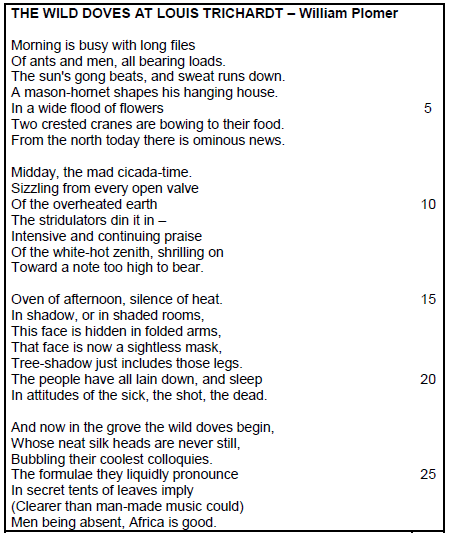
By close reference to the diction, imagery and tone used in this poem, discuss how the speaker explores the contrasting reactions of man and animals to Africa.
Your response should take the form of a well-constructed essay of 250–300 words (about ONE page). [10]
OR
QUESTION 2: POETRY – CONTEXTUAL QUESTION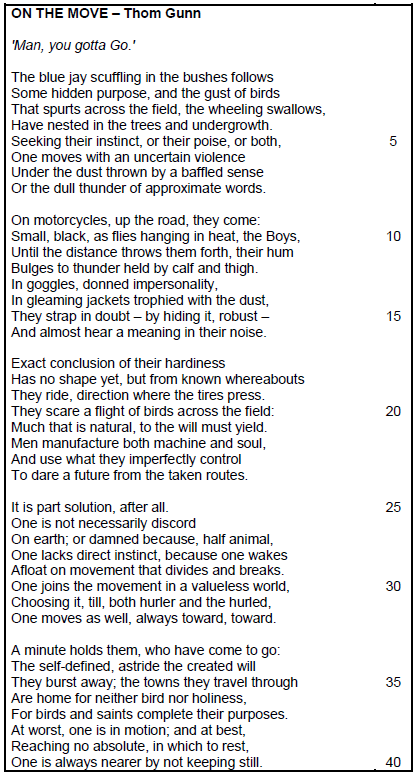
2.1 Refer to line 11: 'Until the distance throws them forth'.
Account for the use of the word, 'throws' in the above line. (2)
2.2 What impression of the bikers is created by 'Has no shape yet' (line 18)? (2)
2.3 Comment on the appropriateness, in context, of the image, 'In gleaming jackets trophied with the dust' (line 14). (3)
2.4 Refer to line 21: 'Much that is natural, to the will must yield.'
Discuss how the tone used in this line reflects the speaker's attitude to people. (3) [10]
OR
QUESTION 3: POETRY – CONTEXTUAL QUESTION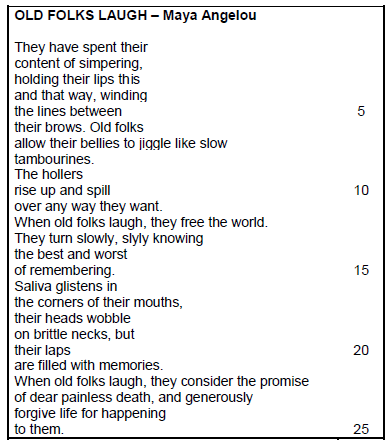
3.1 What does the contrast between 'simpering' (line 2) and 'hollers' (line 9) suggest about the old folk? (2)
3.2 Refer to lines 16–19: 'Saliva glistens in … on brittle necks'.
What does the diction in these lines convey about old age? (2)
3.3 'When old folks laugh, they free the world' (line 12).
Comment on the appropriateness of this line in the context of the poem. (3)
3.4 Refer to lines 22–25: 'When old folks … to them.'
Discuss what the speaker's tone in these lines conveys about her attitude to old folk. (3) [10]
OR
QUESTION 4: POETRY – CONTEXTUAL QUESTION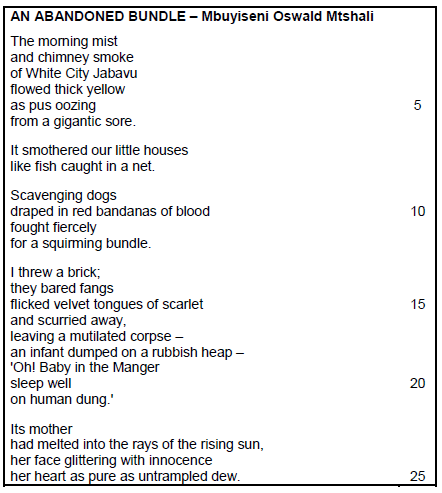
4.1 What does the word, 'smothered' (line 7) indicate about conditions in White City Jabavu? (2)
4.2 Refer to line 10: 'draped in red bandanas of blood'.
What impression is created of the dogs in this line? (2)
4.3 Refer to line 15: 'flicked velvet tongues of scarlet'.
Comment on the appropriateness of this image in the context of the poem. (3)
4.4 Refer to lines 19–21: 'Oh! Baby … on human dung.'
Discuss what the speaker's tone in these lines conveys about his attitude to society. (3) [10]
AND
UNSEEN POETRY (COMPULSORY)
QUESTION 5: CONTEXTUAL QUESTION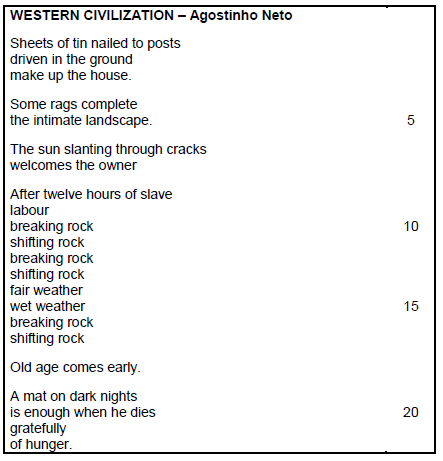
5.1 What impression of the house is created in lines 1–3: 'Sheets of tin ... up the house'? (2)
5.2 Refer to 'breaking rock/shifting rock' in stanza 4: 'After twelve hours ... shifting rock'.
Explain the effect of the repetition of these lines. (2)
5.3 Refer to lines 4–5: 'Some rags complete/the intimate landscape.'
Explain how these lines contribute to the mood of the poem. (3)
5.4 Refer to the final stanza: 'A mat on … gratefully/of hunger.'
Comment on the tone of this stanza in relation to the title of the poem. (3) [10]
TOTAL SECTION A: 30
SECTION B: NOVEL
Answer ONLY on the novel you have studied.
ANIMAL FARM – George Orwell
Answer EITHER QUESTION 6 (essay question) OR QUESTION 7 (contextual question).
QUESTION 6: ANIMAL FARM – ESSAY QUESTION
In Animal Farm, the division of society into classes contradicts the intention of the revolution.
Assess the validity of the above statement.
Your response should take the form of a well-constructed essay of 400–450 words (2–2½ pages). [25]
OR
QUESTION 7: ANIMAL FARM – CONTEXTUAL QUESTION
Read the extracts below and then answer the questions that follow.
EXTRACT A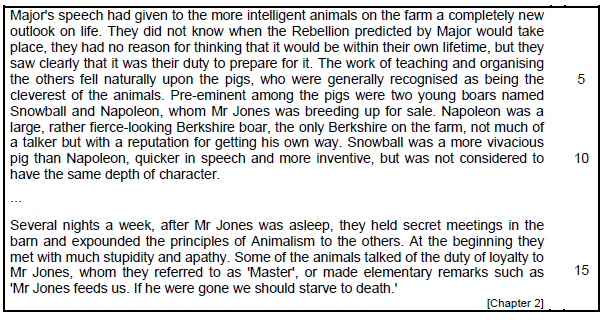
7.1 Using this extract as a starting point, explain how the pigs use their intelligence to their advantage. (3)
7.2 Refer to lines 7–9: 'Napoleon was … his own way.'
How is the description of Napoleon consistent with his behaviour later in the novel? (3)
7.3 Comment on how the loyalty shown by the animals toward their 'Master' (line 15) and toward the pigs ultimately leads to their downfall (3)
7.4 Snowball 'was not considered to have the same depth of character' (lines 10–11) as Napoleon.
Discuss the irony of the above statement. (3)
AND
EXTRACT B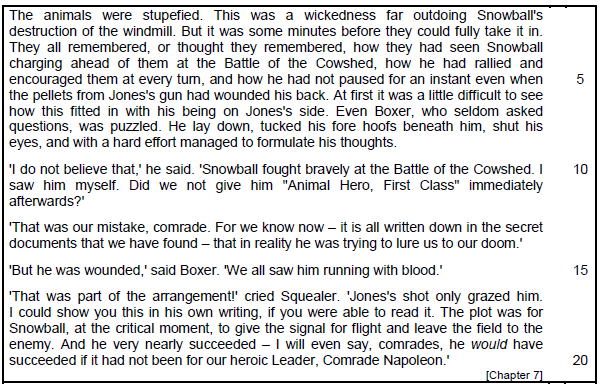
7.5 Comment on Napoleon's determination to destroy Snowball's reputation. (3)
7.6 Explain the significance of Squealer's use of the word, 'comrade' (line 13) in the context of the novel as a whole. (3)
7.7 Boxer represents the ordinary worker who is essential to the success of any society.
By referring to events on Animal Farm, critically discuss this statement. (3)
7.8 The subtitle of the novel is 'A Fairy Story'.
Using the above extracts as a starting point, discuss the extent to which you consider the subtitle appropriate to the novel. (4) [25]
OR
PRIDE AND PREJUDICE – Jane Austen
Answer EITHER QUESTION 8 (essay question) OR QUESTION 9 (contextual question).
QUESTION 8: PRIDE AND PREJUDICE – ESSAY QUESTION
In Pride and Prejudice, Austen presents a society with a strict class hierarchy. Such a society can be poisonous to its members.
Assess the validity of the above statement.
Your response should take the form of a well-constructed essay of 400–450 words (2–2½ pages). [25]
OR
QUESTION 9: PRIDE AND PREJUDICE – CONTEXTUAL QUESTION
Read the extracts below and then answer the questions that follow.
EXTRACT A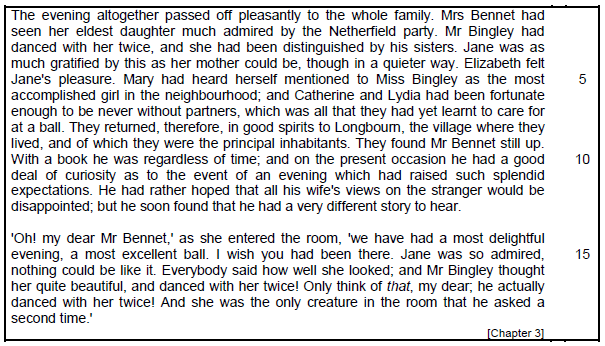
9.1 Explain how this extract serves as an introduction to the courtship practices of Austen's society. (3)
9.2 Refer to line 3: 'she had been distinguished by his sisters.'
Account for the change in attitude of the Bingley sisters toward Jane later in the novel. (3)
9.3 Refer to lines 6–8: 'Catherine and Lydia ... at a ball.'
Discuss how Lydia's insensitivity to appropriate social behaviour has an impact later in her life. (3)
9.4 Refer to lines 12–13: 'He had rather … would be disappointed'.
Drawing on your knowledge of Mr Bennet, comment on his attitude as expressed in this statement. (3)
AND
EXTRACT B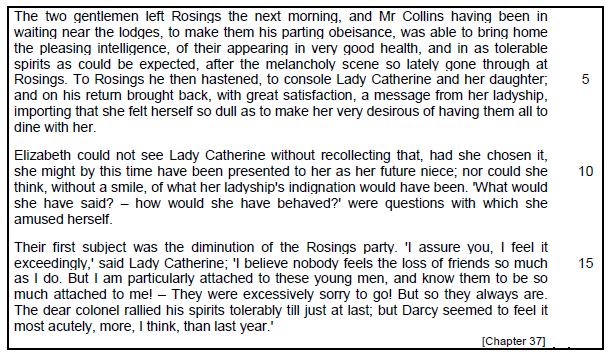
9.5 Comment on Darcy's motives for prolonging his stay at Rosings. (3)
9.6 'Mr Collins having been in waiting near the lodges, to make them his parting obeisance' (lines 1–2).
Comment on how Austen's satirical portrayal of Mr Collins is typical of him. (3)
9.7 Critically discuss how Elizabeth's attitude to social class sets her apart from other women of her society.(3)
9.8 Lady Catherine and Mrs Bennet are not as different as they might appear to be.
Using the above extracts as a starting point, discuss the extent to which you agree with this statement. (4) [25]
OR
THE GREAT GATSBY – F Scott Fitzgerald
Answer EITHER QUESTION 10 (essay question) OR QUESTION 11 (contextual question).
QUESTION 10: THE GREAT GATSBY – ESSAY QUESTION
In The Great Gatsby, the division of society into classes contradicts the concept of the American Dream.
Assess the validity of the above statement.
Your response should take the form of a well-constructed essay of 400–450 words (2–2½ pages). [25]
OR
QUESTION 11: THE GREAT GATSBY – CONTEXTUAL QUESTION
Read the extracts below and then answer the questions that follow.
EXTRACT A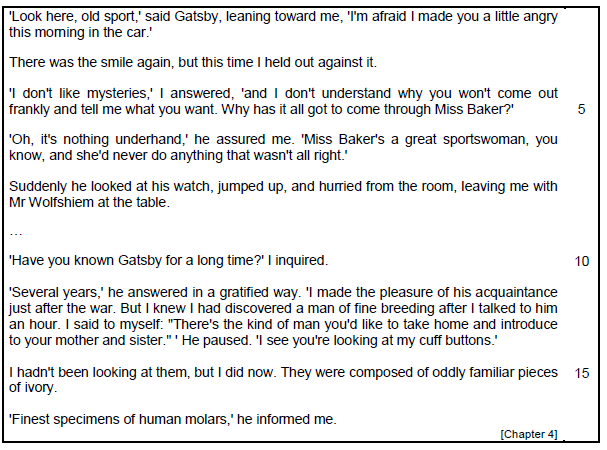
11.1 Refer to line 5: 'Why has it all got to come through Miss Baker?'
Account for Gatsby's using Jordan to convey his request to Nick. (3)
11.2 Refer to lines 6–7: 'Miss Baker's … wasn't all right.'
Explain whether Gatsby's assessment of Jordan's character is an accurate one. (3)
11.3 Refer to line 3: 'There was the … out against it.'
Based on your knowledge of the novel as a whole, discuss what this line suggests about Nick's response to Gatsby. (3)
11.4 How does the inclusion of Wolfshiem in the novel make a comment on the American Dream? (3)
AND
EXTRACT B
11.5 Refer to lines 3–4: 'What'll we do … next thirty years?'
Explain how Daisy's words in these lines reflect the attitude of the upper class. (3)
11.6 In this extract, there is repeated reference to the heat.
Comment on the symbolism of the weather as presented in this extract and in the novel as a whole. (3)
11.7 Critically discuss the irony of Gatsby's remark that he 'can't say anything in his [Tom's] house' (line 25). (3)
11.8 Gatsby's optimism about the future is based on an illusion.
Using the above extracts as a starting point, discuss the extent to which you agree with this statement. (4) [25]
TOTAL SECTION B: 25
SECTION C: DRAMA
Answer ONLY on the play you have studied.
OTHELLO – William Shakespeare
Answer EITHER QUESTION 12 (essay question) OR QUESTION 13 (contextual question).
QUESTION 12: OTHELLO – ESSAY QUESTION
Othello is a tragedy of misunderstanding.
Critically discuss the validity of the above statement.
Your response should take the form of a well-constructed essay of 400–450 words (2–2½ pages). [25]
OR
QUESTION 13: OTHELLO – CONTEXTUAL QUESTION
Read the extracts below and then answer the questions that follow.
EXTRACT A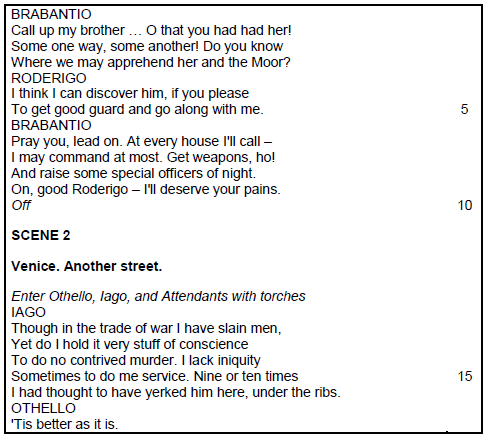
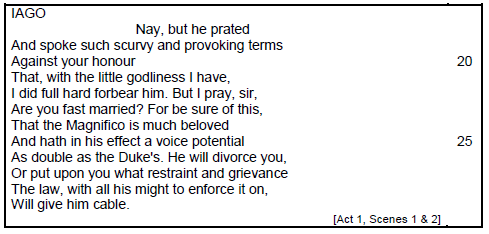
13.1 Refer to lines 4–5: 'I think I can … along with me.'
Explain why Roderigo is ready to assist Brabantio. (3)
13.2 Refer to lines 23–26: 'For be sure … as the Duke's.'
Account for Iago's warning Othello about Brabantio. (3)
13.3 Refer to lines 14–15: 'I lack iniquity sometimes to do me service.'
Drawing on your knowledge of the play as a whole, explain the irony in these lines. (3)
13.4 Refer to lines 27–28: 'Or put upon ... enforce it on'.
By focusing on the reference to 'the law', discuss the significance of moving the action of the play to Cyprus. (3)
AND
EXTRACT B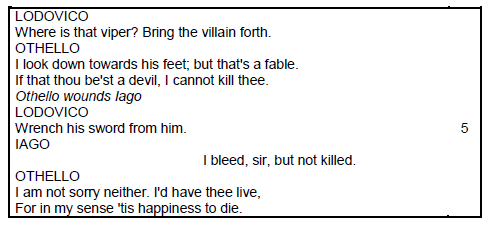
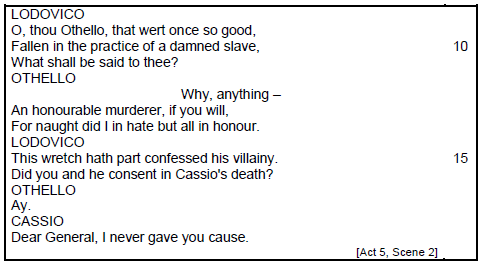
13.5 Account for Lodovico's reference to Iago as a 'viper' (line 1). (3)
13.6 Refer to lines 2–3: 'I look down … cannot kill thee.'
Explain how the image in these lines contributes to your understanding of Othello's attitude toward Iago at this stage in the play. (3)
13.7 Refer to lines 13–14: 'An honourable murderer … all in honour.'
Critically discuss how these lines influence your reaction to Othello. (3)
13.8 The play, Othello, is characterised by irrational behaviour.
Do you agree? Justify your response by providing evidence from the play as a whole. (4) [25]
OR
THE CRUCIBLE – ARTHUR MILLER
Answer EITHER QUESTION 14 (essay question) OR QUESTION 15 (contextual question).
QUESTION 14: THE CRUCIBLE – ESSAY QUESTION
The Crucible is a play in which ignorance and superstition provide the perfect breeding ground for tragedy.
Critically discuss the validity of the above statement.
Your response should take the form of a well-constructed essay of 400–450 words (2–2½ pages). [25]
OR
QUESTION 15: THE CRUCIBLE – CONTEXTUAL QUESTION
Read the extracts below and then answer the questions that follow.
EXTRACT A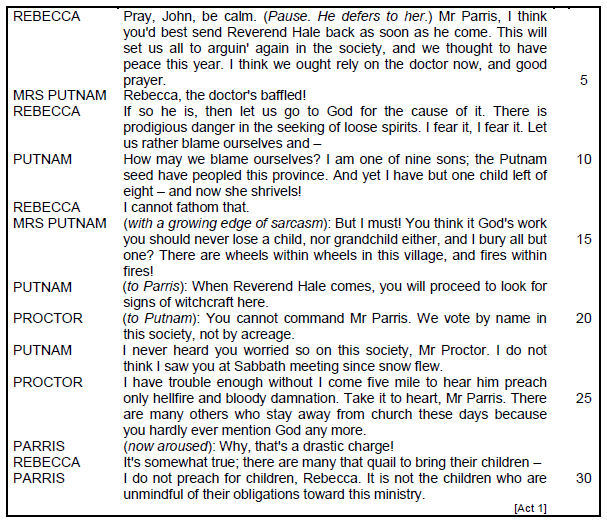
15.1 Refer to line 1: 'Pray, John, be calm. (Pause. He defers to her.)'
15.1.1 Account for Rebecca's advising Proctor to 'be calm'. (3)
15.1.2 What does Proctor's positive response suggest about Rebecca's position in society? (3)
15.2 Refer to lines 20–21: 'We vote by name in this society, not by acreage.'
Using this sentence as a starting point, comment on Proctor's attitude to status. (3)
15.3 Proctor accuses Parris of preaching 'only hellfire and bloody damnation' (line 25).
By focusing on the reference to 'hellfire and bloody damnation', discuss the nature of justice in Salem. (3)
AND
EXTRACT B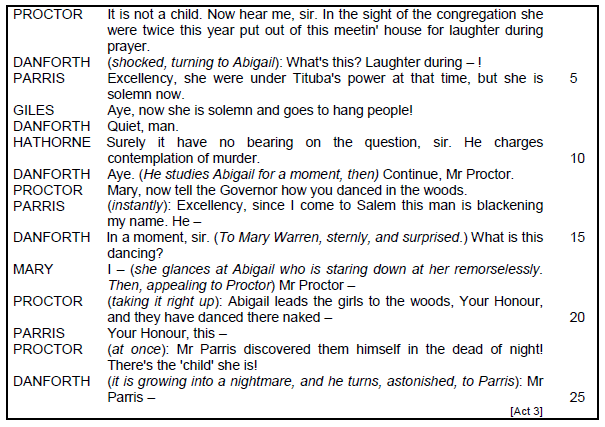
15.4 Comment on the description of Abigail as 'solemn' (line 6). (3)
15.5 Refer to Danforth's words: 'What's this? Laughter during – !' (line 4) and 'Quiet, man' (line 8).
Comment on the irony of Danforth's reactions in these lines. (3)
15.6 Refer to the stage directions in lines 17–18: '(she glances at Abigail … appealing to Proctor)'.
Critically discuss how these stage directions influence your reaction to Mary. (3)
15.7 The play, The Crucible, is characterised by irrational behaviour.
Do you agree? Justify your response by providing evidence from the play as a whole. (4) [25]
TOTAL SECTION C: 25
GRAND TOTAL: 80
